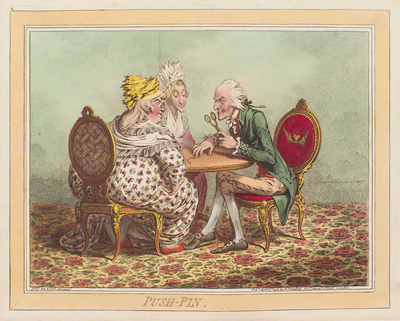Push-Pin
Push-Pin shows a leering Duke of Queensberry sitting at a round table with two women playing at a children's game whose name, in this context, would have been clearly suggestive for Gillray's audience.

© National Portrait Gallery, London
The Duke of Queensberry was a notorious lecher and gambler, who was infamous for preying upon young women. His reputation is suggested with less subtlety by Robert Dighton in 1796 in a print called Old q-uiz the old goat of Piccadilly and by Woodward in 1800 in a print called Every Body in Town where the Duke chucks a young woman under the chin and invites her to ride his "little Horse."
In this case, Queensberry is playing the game against a fat woman who has been identified as the reputed bawd, Mother Windsor. Gillray portrays the scene at the moment when Queensberry knows he has won the game. His gaze is directed with triumph at Mother Windsor. Her gaze of surprise and alarm is directed at the pins where the crooked pin of Queensberry is surmounting her straight pin.
An attractive young woman is seated between the two competitors, but since there are only two pins on the table, she is most likely the prize not a player. Elements of the Queensberry crest (heart and crown) appear on the Duke's chair back, but Gillray has added wings to suggest perhaps the fleeting quality of Queenberry's interest in this game.
Sources and Reading
- Commentary from the British Museum on Push-Pin
- Draper Hill, Fashionable Contrasts, 1966, #88
- "Duke of Queensberry," Georgian Gentleman
- "William Douglas, 4th Duke of Queensberry," Wikipedia
- Thomas Wright and R.H. Evans, Historical and Descriptive Account of the Caricatures of James Gillray #439
Comments & Corrections
NOTE: Comments and/or corrections are always appreciated. To make that easier, I have included a form below that you can use. I promise never to share any of the info provided without your express permission.